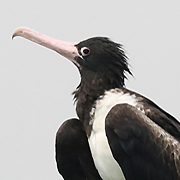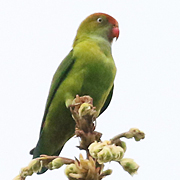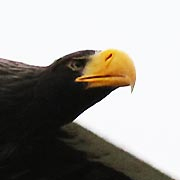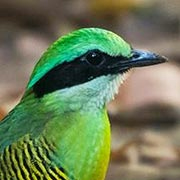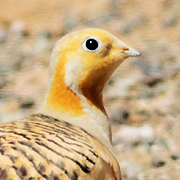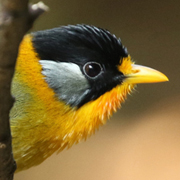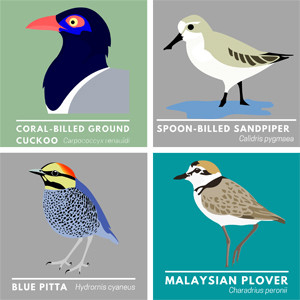
On 23rd March I collected Andreas Egelund Christensen at 5am from his hotel near Silom Road: Room at Silom Hotel. We arrived at Laem Pak Bia at about 7am and made our first stop at the spot which has been used as a wintering site by a pair of Black-faced Spoonbills: Black-faced Spoonbill wintering site 2008. However, at this time they were not present but a walk around the scrubby vegetation turned up an Oriental Reed Warbler, a pair of Indochinese Bushlarks, an Oriental Skylark, a pair of Plain-backed Sparrows amongst some more common birds. The salt pans here held a single Little Stint in breeding plumage, a number of Curlew Sandpipers as well as Marsh Sandpiper, Kentish Plover, Lesser Sand Plover, Whiskered Tern and Great Egret. In the time it took us to look at these birds on of the Black-faced Spoonbills had arrived and joined a group of Grey Herons and as we watched, the other spoonbill flew in. They proceeded to preen each other in a fashion that suggested courtship behaviour and after watching for 5-10 minutes we left them to it.
Moving on we stopped in hope of Great Knot and Nordmann’s Greenshank. At first all we saw was a large group of Lesser Sand Plovers and Kentish Plovers. I say “all we saw” but at this time of year these birds are beautiful in their breeding colours. Whilst watching these we located a group of Great Knot but the Nordmann’s Greenshank were not present, although a group of over 500 Black-tailed Godwits was impressive.
Standing watching these birds we added White-winged Tern, Common Greenshank, Brown-headed Gull, Gull-billed Tern, Osprey, Red-necked Stint and Long-toed Stint to our list; Andreas was particularly interested in the latter as it was a “lifer” for him.
Rather frustratingly, 6 Nordmann’s Greenshank flew in but did not land, they just flew off into the distance. They could be identified by their pale appearance and white underwings, but this view was not at all satisfying. With this event we decided to move onto Pak Thale for the Spoon-billed Sandpiper.
There is now a sign indicating where to turn for this site at Pak Thale – it is very easy to see and is in English with a picture of a Spoon-billed Sandpiper – this map will also help: Spoon-billed Sandpiper map.

Unfortunately for us, most of the Spoon-billed Sandpipers seemed to have departed and recently have been infrequently seen. One had been seen early in the morning but had left by 9.30 am, much earlier than usual. Lots of other birds were available and Little Tern, Red-necked Phalarope and Broad-billed Sandpiper were nice. However, at the mangrove remnants on the sea a fantastic Ruddy Kingfisher perched for a while in a dead tree before flying into dense mangrove cover – what a piece of luck! Amongst the mangroves we found several Dusky Warblers, Pied Fantail and Golden-bellied Gerygone. On the mudflats a number of Eurasian Curlews were feeding as well as many Javan Pond Herons in breeding plumage – no Chinese Pond Herons in breeding plumage were seen.
Feeling the heat we went for some lunch and arranged a boat for the trip to the sand spit. Before the trip though we had time for an hour at the King’s Project. At this time of day the numbers of birds were not so impressive but we found a Black-crowned Night Heron, plenty of Indian and Little Cormorants, Little Egret, Great Egret, Intermediate Egret, Grey Heron and much more.
A monitor lizard eating one of its own kind was an amazing sight and offered a chance for some photographs. read about this encounter and see the photos here: Cannibalistic Monitor Lizard.
In the freshwater filter and reed beds we also found Ruff, White-breasted waterhen and a couple of Ruddy-breasted Crakes as well as a Black-browed Reed Warbler before we headed for our boat trip.
As usual we saw Collared and Black-capped Kingfishers and 2 Chinese Egrets treated us to a great close-up view before flying away. On the sand bar the usual collection of caspian, Lesser Crested, Great Crested, Little and Common Terns were present and on the sand spit malaysian Plover was easily found. However, our quest for “White-faced” Plover was rather trickier and required us to wade through water to investigate the beach further up. Great Sand Plover, Sanderling and many Kentish Plovers were easily seen and just as we were about to give up we found the “White-faced” Plover on a small sand island. After viewing it for some time we headed back to the boat but got very wet wading though waist-deep water as the tide came in!
Our day was almost over but we had time to take another look at Pak Thale. On the way some other birders gave us reason to stop and amongst the large flock of Great Knot, Pacific Golden Plovers, Grey Plovers and other shorebirds were a group of 6 Nordmann’s Greenshank – very satisfying.
However, we weren’t ot be so lucky at Pak Thale and encountered other birders on the same search as us. One more bird for the day list was added though – a Dunlin – a very uncommon bird in Thailand.
We both had a good day however, with almost 100 species seen and pleasant company. The journey back to Bangkok was a little tiresome though, taking over 3 hours due to heavy traffic.
Some photos from Laem Pak Bia/Pak Thale.
birds, birding, thailand, nature, national parks, photography


 March 31st, 2008
March 31st, 2008  Nick
Nick 




 Posted in
Posted in 
